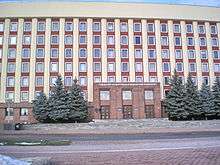Gomel State Medical University
| Гомельский государственный медицинский университет | |
 Gomel State Medical University | |
Former names | Gomel State Medical Institute |
|---|---|
| Type | public |
| Established | 1990 |
| Rector | Lyzikov Anatoly Nikolaevich |
Academic staff | 276 |
| Students | 3500 |
| Location |
Gomel, Belarus 52°26′43″N 30°59′32″E / 52.44528°N 30.99222°ECoordinates: 52°26′43″N 30°59′32″E / 52.44528°N 30.99222°E |
| Campus | Urban |
| Website |
gsmu |
Gomel State Medical University (Homiel State Medical University, Гомельский государственный медицинский университет; former name: Gomel State Medical Institute) is public teaching university based in Gomel, Belarus.
History
In 1990 Gomel State Medical University was founded as per resolution of the Council of Ministers and Order of the Minister of Health of the Byelorussian Soviet Socialist Republic. It is the youngest of four medical universities in Belarus.
Education
The main campus of Gomel State Medical University is located in downtown Gomel, with 18 adjacent clinical sites spread across the city. Faculty includes 276 members with more than one-third holding MD/PhD degree.
Education at Gomel State Medical University includes five to six-year programs in basic and clinical medical science. Upon admission to University students enter one of four different schools (faculties): General Medicine, Medical Diagnostics, Education for Foreign Students or the Faculty of Pre-University Training - a one-year program which provides the full-time undergraduate course for admission to University.
Graduates of the University obtain M.D. degree and are required to complete a minimum of a one-year internship in order to practice clinical medicine. Education of foreign students at Gomel State Medical University started in 2003.
International cooperation
The main directions of international cooperation between education institutions are:
- Enhancing the role of the University in international educational space and in the international market of educational services;
- Development of international relations with foreign educational institutions;
- The implementation of cultural and academic exchanges between partner universities for the study of promising areas of educational process;
- Introduction of innovative educational approaches, improving the scientific and professional level of teachers and students;
- Ensuring the participation of departments, staff, and students in international projects, programs, and competitions;
- Dissemination of information about the educational services of the University;
- Organisation of international scientific conferences and seminars.
Rectors
- Yury Bandazhevsky (1990-1999)
- Sergei Vladimirovich Zavoronok (1999-2007)
- Anatoly Nikolayevich Lyzikov (2007-current)